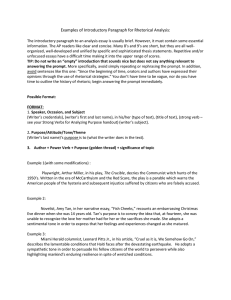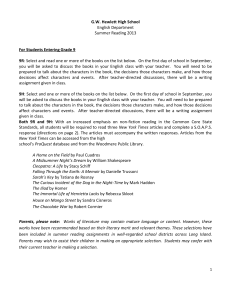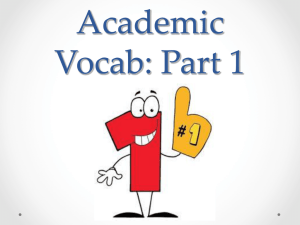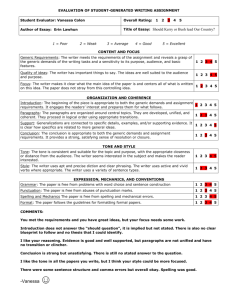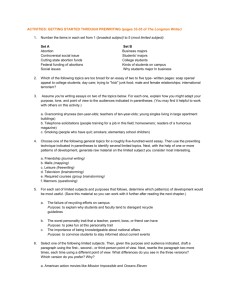Introduction to Unit 8: Style and Voice
advertisement
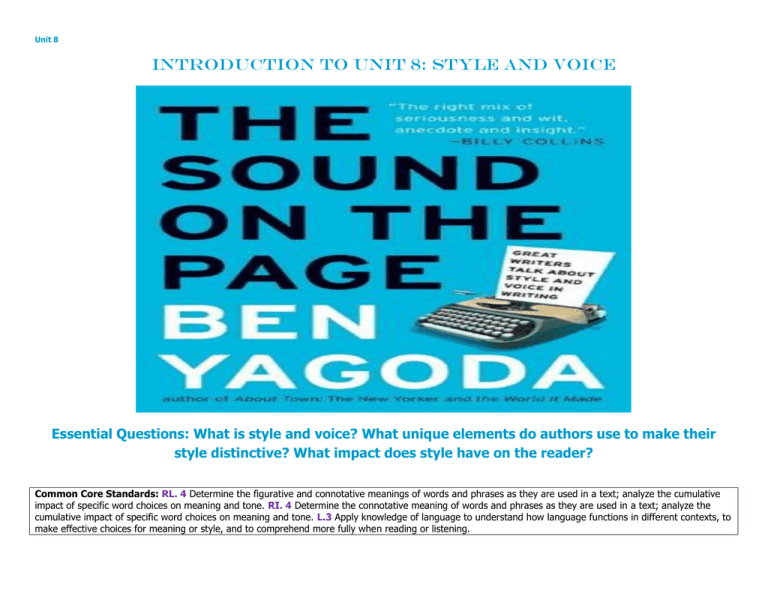
Unit 8 Introduction to Unit 8: Style and Voice Essential Questions: What is style and voice? What unique elements do authors use to make their style distinctive? What impact does style have on the reader? Common Core Standards: RL. 4 Determine the figurative and connotative meanings of words and phrases as they are used in a text; analyze the cumulative impact of specific word choices on meaning and tone. RI. 4 Determine the connotative meaning of words and phrases as they are used in a text; analyze the cumulative impact of specific word choices on meaning and tone. L.3 Apply knowledge of language to understand how language functions in different contexts, to make effective choices for meaning or style, and to comprehend more fully when reading or listening. Introduction: What makes country music different than reggae? How can you discern the difference between a hair-raising Edgar Allan Poe story and a Stephen King page-turner? The answer is style. Style is the unique elements that make everything, from music to writing, distinctive. Style is what helps readers tell National Geographic from National Enquirer or a Shakespearean sonnet from a poem by Robert Frost. Typically, the style of what you read can affect your just as much as the content or substance. In this unit, you will learn about how authors create their own unique styles and the affect style has on readers. What music or bands do you like? Is there a specific movie director or author that you feel especially drawn to? The answer to these questions is often attributed to style. With a small group of peers, list your favorite artists: actors, songwriters, painters, authors, or directors. Once you have created a list of artists, answer the following questions: What about the artist’s work is unique? Are there characteristics that make his or her work instantly recognizable? What brings the artist’s work together? For instance, maybe your favorite band uses the same imagery in all of their lyrics. What three words would you use to describe your artist’s style? Section 1: Style and Voice Have you ever sent a simple text or email to a friend or family member that that confused or upset them? Chances are that it was not what you said, but how they thought you said it. This is related to style. In literature, style is the way a particular work is written – not what is said, but how it’s said. A writer’s style, usually reflecting the context in which the work is written, depends on many elements, including the writer’s choice or words, tone, and sentence structures. Does the writer use long sentences packed with elaborate details or one that short and straight to the point? Is the tone genuine or spiked with sarcasm? Common Style FORMAL Uses sophisticated, abstract language May use complex sentence structures Carefully observes rules of grammar INFORMAL Sounds like everyday conversation May use contractions and slang May use simple sentences and fragments Journalistic Uses neutral words to report facts Example And was Mr. Rochester no ugly in my eyes? No, reader; gratitude and many associations, all pleasurable and genial, made his face the object I best liked to see… -from Jane Eyre by Charlotte Bronte Remember that boy you thought you could not live without? What was his name? Randy. You don’t remember? -From The Kitchen God’s Wife by Amy Tan A lightening flash can happen in half a second. In that instant, the lightening flash superheats the surrounding air to a temperature five Often includes simple sentences Reader notices what’s said, not who’s talking Literary May use imagery to communicate a mood Often includes long, elaborate sentences Reader often gets to know the narrator-the voice that tells the story times hotter than that on the surface of the sun. -from nationalgeographic.com The lightening quivered about the pinnacles of the ancient Hotel de Ville, and shed flickering gleams over the open space in front. -from “The Adventure of the German Student” by Washington Irving MODEL 1: Style This excerpt comes from a celebrated novel about life on the Nebraska prairie. While reading, think about the common styles presented on the chart above. Which style or styles do you think exemplify the writing? From My Antonia Close Read A Novel by Willa Cather While the train flashed through never-ending miles of ripe wheat, by country towns and bright-flowered pastures and oak groves wilting in the sun, we sat in the observation car, where the woodwork was hot to the touch and red dust lay deep over everything. The dust and heat, the burning wind, reminded us of many things. We were talking about what it is like to spend one’s childhood in little towns like these, buried in wheat and corn, under stimulating extremes of climate: burning summers when the world lies green and billowy beneath a brilliant sky, when one is fairly stifled in vegetation, in the color and smell of strong weeds and heavy harvests; blustery winters with little snow, when the whole country is stripped bare and gray as sheet-iron. Notice the sentence length and the use of imagery in the highlighted text. Based on these details, how would you explain the style of this excerpt? Find another detail that enabled you to distinguish the style. MODEL 2: Style In this second example, another wrier provided a contrasting explanation of a prairie. While reading, think about how this writer’s style compares with Willa Cather’s in the first model. From Frairyerth Close Read Nonfiction by William Least Heat-Moon The Flint Hills are the last remaining grand expanse of tallgrass prairie in American. On a geologic map, their shape something like a stone spear point, they cover most of the two-hundred-mile longitude of Kansas from Nebraska to Oklahoma, a stony upland twenty to eighty miles wide. As their western edge, the missed-grass prairie begins and spreads a hundred or so miles to the shortgrass country of the high plains. Is this excerpt literary or journalistic? Support your answer by pointing out facts from the text. Contrast Heat-Moon’s style with Cather’s. Identify two specific differences. Section 2: Style and Voice Nearly every choice an author makes contributes to the style of his or her work. These choices also help to create a voice, or the personality that is presented on the page. The voice may be the writer’s, or it may belong to a fictional character in the story. Below, two author’s share their feelings about their craft. A close examination of three important elements-word choice, sentence structure, and tone – in these passages can better help you comprehend each writer’s distinctive style. Comparing Styles “It is the [the writer’s] privilege to help man ensure by lifting his “The very first thing I tell my new students on the first day of this heart, by remind him of the courage and honor and hope and workshop is that good writing is about telling the truth. We see a pride and compassion and pity and sacrifice which have been the species that needs and wants to understand who we are. Sheep glory of his past”. lice to not seem to share this longing, which is one reason they -William Faulkner, Nobel Prize acceptance speech, 1950 write so very little. -Anne Lamott, Bird by Bird Word Choice If you’ve ever been challenged to find the perfect words to describe something, then you know how critical word choice can be. A tall person can be gigantic, puny, even colossal, - or just tall. The denotation (literal meaning) is the same, but the connotations (emotional associations) are entirely different. In his speech, Faulkner uses formal, dramatic words and phrases. For instance, “the glory of his past” – emphasize the serious responsibility of the writers. Lamott’s writing, however, is more conversational. Her use of I and we, and phrases like “the very first thing,” contributes to her personable style. Sentence Structure Sentences can be long and complex (like Faulkner’s) or short and to the point (like Lamott’s). Faulkner’s excerpt is one long sentence that threads together hope, courage, and other weighty words with a series of and’s. This structure adds to the dramatic impact of the writing and helps to produce its formal style. Tone Tone is the writer’s attitude toward a subject, as communicated through word choice and details. Faulkner’s focus on the writer’s “privilege” communicates a formal tone. Lamott, however, scampers playfully from truth to sheep lice. Such incongruous details help to generate a humorous tone. MODEL 1: Elements of Style Sandra Cisneros has a unique and distinguishable style of writing. While you read the excerpt below, note her word choice and the structure of her sentences. To fully appreciate her style, read the excerpt aloud or listen to a classmate read. Think about whether it sounds like someone writing or someone talking. From Geraldo No Last Name Close Read Vignette by Sandra Cisneros She met him at a dance. Pretty too, and young. Said he worked in a restaurant, but she can’t remember which one. Geraldo. That’s all. Green pants and Saturday shirt. Geraldo. That’s what he told her. And how was she to know she’d be the last one to see him alive. An accident, don’t you know. Hit and run. Marin, she goes to all those dances. Uptown. Logan. Embassy. Palmer. Aragon. Fontana. The manor. She likes to dance. She knows how to do cumbias and salsas and rancheras even. And he was just someone she danced with. Somebody she met that night. That’s right. That’s the story. That’s what she said again and again. Once to the hospital people and twice to the police. No address. No name. Nothing in his pockets. Describe the structure of the highlighted sentences. What effect do these sentences have on the style of the excerpt and the narrator’s voice? Find an example of word choice that would not belong in a story written in a formal style. MODEL 2: Elements of Style From Pride and Prejudice Close Read Novel by Jane Austen Elizabeth Bennet had been obliged by the scarcity of gentlemen to sit down for two dances; and during part of the time, Mr. Darcy had been standing near enough for her to overhear a conversation between him and Mr. Bingley, who came from the dance for a few minutes to press his friend to join it. “Come, Darcy,” he said, “I must have you dance. I hate to see you standing about by yourself in this stupid manner. You much better dance.” “I certainly shall not. You know how I detest it, unless I am particularly acquainted with my partner. At such an What specific words and details in this excerpt help to convey a prim and proper tone? Reread the highlighted lines. What sentence structure does assembly as this, it would be insupportable. Your sisters are engaged, and there is not another woman in this room whom it would not be a punishment to me to stand up with.” the writer use for narrator’s voice? Rewrite the blue highlighted text in a conversational tone. Section 3: Style and Voice Now it is time to apply what you’ve just learned about style as you analyze these two excerpts. Though both writers explore the topic of outer space, they have distinctly different styles. The first excerpt come from the classical science fiction novel originally published in 1898. When you read, pay close attention to the elements – word choice, sentence structure, and tone – that reveal the writer’s style. From The War of the Worlds Novel by H.G. Wells A big greyish rounded bulk, the size, perhaps, of a bear, was rising slowly and painfully out of the cylinder. As it bulged up and caught the light, it glistened like wet leather. Close Read One feature of Well’s style is his use of dramatic images to help the reader imagine the Martian. One example is highlighted. Identify three more examples. Two large dark-colored eyes were regarding me steadfastly. The mass that framed them, the head of the thing, was rounded, and had, one might say, a face. There was a mouth under the eyes, the lipless brim of which quivered Reread the sentence that is and panted, and dropped saliva. The whole creature heaved and pulsated convulsively. A lank tentacular appendage highlighted in blue. What do its structure and length gripped the edge of the cylinder, another swayed in the air. accentuate? Those who have never seen a living Martian can scarcely imagine the strange horror of its appearance. The peculiar V-shaped mouth with its pointed upper lip, the absence of brow ridges, the absence of a chin beneath the wedgelike lower lip, the incessant quivering of this mouth, the Gorgon groups of tentacles, the tumultuous breathing of the lungs in a strange atmosphere, the evident heaviness and painfulness of movement due to the greater gravitational energy of the earth--above all, the extraordinary intensity of the immense eyes-were at once vital, intense, inhuman, crippled and monstrous. There was something fungoid in the oily brown skin, something in the clumsy deliberation of the tedious movements unspeakably nasty. Review the styles of writing from your notes. Which style or styles does Well’s writing exhibit? Support your answer citing details from the text. In this next excerpt, the astronaut Sally Ride describes her emotions and impressions as she views her home planet from space. How does Ride’s style compare to the one Wells used in The War of the Worlds? From Single Room, Earth View Essay by Sally Ride Everyone I've met has a glittering, if vague, mental image of space travel. And naturally enough, people want to hear about it from an astronaut: “How did it feel?” “What did it look like?” “Were you scared?” Sometimes, the questions come from reporters, their pens poised and their recorders silently sucking in the words; sometimes, it’s wide-eyed, 10-year-old girls who want answers. I find a way to answer all of them, but it’s not easy. Imagine trying to describe an airplane ride to someone who has never flown. An articulate traveler could describe the sights but would find it much harder to explain the difference in perspective provided by the new view from a greater distance, along with the feelings, impressions, and insights that go with that new perspective. And the difference is enormous: Space flight moves the traveler another giant step farther away. Eight and one-half thunderous minutes after launch, an astronaut is orbiting high above the Earth, suddenly able to watch typhoons form, volcanoes smolder, and meteors streak through the atmosphere below. While flying over the Hawaiian Islands, several astronauts have marveled that the islands look just like they do on a map. When people first hear that, they wonder what should be so surprising about Hawaii looking the way it does in the atlas. Yet, to the astronauts it is an absolutely startling sensation: The islands really do look as if that part of the world has been carpeted with a big page torn out of Rand-McNally, and all we can do is try to convey the surreal quality of that scene. In orbit, racing along at five miles per second, the space shuttle circles the Earth once every 90 minutes. I found that at this speed, unless I kept my nose pressed to the window, it was almost impossible to keep track of where we were at any given moment—the world below simply changes too fast. If I turned my concentration away for too long, even just to grab a camera, I could miss an entire land mass. It’s embarrassing to float up to a window, glance outside, and then have to ask a crewmate, “What continent is this?” Close Read Reread the highlighted sentence. What do you notice about its structure and Ride’s choice of words? Explain whether these elements demonstrate a conversational style or a formal, academic one. Think about the tone that Ride takes toward her topic. Is it excited or disconnected? Cite evidence to support your answer. How would you characterize Ride’s voice? In other words, how is her personality is shared through her writing? Explain your answer using evidence from the text. Contrast Ride’s and Well’s styles. Use examples from both texts and provide three important differences.
